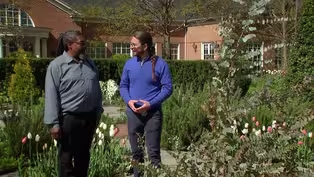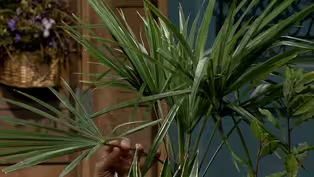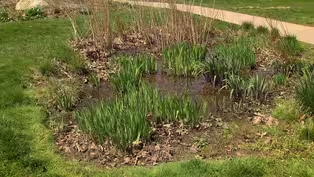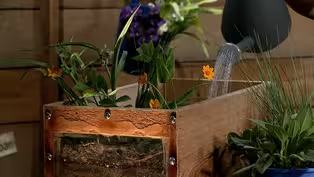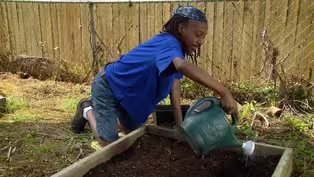Virginia Home Grown
Clippings: Climate Change Impacts
Clip: Season 24 Episode 2 | 26m 46sVideo has Closed Captions
Discover ways that climate change is impacting the Commonwealth.
Serome Hamlin tours Lewis Ginter Botanical Garden with Danny Cox, to see how new USDA hardiness zones are challenging public gardens. Peggy Singlemann learns how marshes and wetlands can create more resilient shorelines and buffer against sea level rise in Norfolk with Wetlands Watch. Engage with us at facebook.com/VirginiaHomeGrown and vpm.org/vhg. VHGC 406.
Problems playing video? | Closed Captioning Feedback
Problems playing video? | Closed Captioning Feedback
Virginia Home Grown is a local public television program presented by VPM
Virginia Home Grown
Clippings: Climate Change Impacts
Clip: Season 24 Episode 2 | 26m 46sVideo has Closed Captions
Serome Hamlin tours Lewis Ginter Botanical Garden with Danny Cox, to see how new USDA hardiness zones are challenging public gardens. Peggy Singlemann learns how marshes and wetlands can create more resilient shorelines and buffer against sea level rise in Norfolk with Wetlands Watch. Engage with us at facebook.com/VirginiaHomeGrown and vpm.org/vhg. VHGC 406.
Problems playing video? | Closed Captioning Feedback
How to Watch Virginia Home Grown
Virginia Home Grown is available to stream on pbs.org and the free PBS App, available on iPhone, Apple TV, Android TV, Android smartphones, Amazon Fire TV, Amazon Fire Tablet, Roku, Samsung Smart TV, and Vizio.
Providing Support for PBS.org
Learn Moreabout PBS online sponsorship(upbeat music) Without the ability for wetlands to migrate landward, we will lose 89% of our tidal wetlands by 2080.
It's pretty early and these cherries have already bloomed.
I'm a little concerned about what this might mean for our pollinators.
Things that are seeking that pollen, that first source of food.
You know, they're not able to get it.
And these flowers are already gone.
>>Production funding for "Virginia Home Grown" is made possible by the Mary Roper Davis and Robert Poore Roper Memorial Fund and by.
(critters chirping) (lively music) (lively music continues) (lively music continues) Welcome to Virginia Home Grown!
Today we are examining the impacts of climate change on our landscapes and gardens and steps both homeowners and communities can take to adapt.
First, we join Serome Hamlin at Lewis Ginter Botanical Garden in Richmond to learn about the challenges and opportunities for growing in a warmer hardiness zone.
>>Recently the USDA has changed its hardiness zone map.
What does that mean, and what does that mean also for public gardens such as here at Lewis Ginter?
>>Yeah, well, thanks for being here.
The USDA changes that every 30 years based on the data, and it's looking at the minimum cold temperatures.
And that means our area here in Richmond, we're actually a zone warmer than we used to be.
But this doesn't encapsulate everything that we should be thinking about or the kind of the larger issue at hand of climate change.
The hardiness zone map is a great way for gardeners, horticulturists, and agriculturists to kind of help identify and select the right plants for their place, but we should also be talking about heat tolerance.
And so I think there's a opportunity even within those two subjects to talk about microclimates, storm water, and the rainfall, and how that's changing in addition to changing temperatures.
But probably one of the more exciting silver linings to this kind of bigger discussion is plant selections, specifically around zone pushing, and to your original question about the USDA hardiness zone map.
And so there's some really great opportunities that we can talk about here at the garden and our collections that we're starting to implement as we think about what plants we can be growing here for the future.
The first example I have is of this dwarf pomegranate here.
This pomegranate actually overwintered successfully this past year.
Last summer it fruited, it had these great little fruits.
There's actually some.
>>Yeah, you can see some of the seed pods leftover from last season.
>>Yeah.
Yeah.
This dwarf pomegranate is great for charcuterie boards.
I love throwing them in smoothies.
It's not like the big pomegranate that you see at the grocery store, but it has excellent taste.
And it's perfect for door yard, fruit tree, or small gardens.
>>And whoever knew you could grow a pomegranate in Central Virginia.
>>Right.
Yeah.
>>So are there any other examples of plants that's pushing the zone that you can show us?
>>Yeah, we have several examples.
There's actually a eucalyptus right over here.
It's a plant that we've had in the garden now for a couple years.
It's tried and true.
We know it's winter hardy.
We're actually kind of cutting it back and keeping a really healthy root stock so it always is able to come back even in the worst winters, but this winter we didn't even have to cut it back.
So this has a really great form to it.
It's more of a natural form, and that's kind of how we've pruned it.
But it's got beautiful silver foliage.
There's bright red new stems coming out.
Again, this is tried and true.
We're looking at adding this throughout the garden moving forward.
>>I hear your moving it out into the parking lot, so that's saying something about this plant and it's hardiness now.
>>Yeah, and really the parking lot, it's not just the winter hardiness there, but the overall exposure, dry conditions.
Plants have to be pretty tough to be in a parking lot.
>>Parking lot.
Exactly.
>>You wanna go take a look at another example?
>>Yes.
Let's go do some more exploring.
(birds chirping) >>So another thing that we have to think about as gardeners now the USDA zone has changed and the implications really just overall what it means to have a changing climate is pest and diseases in the garden and how that's gonna impact the plants that we're trying to grow.
And one that's actually coming to mind as we walk through the garden over to the rose garden is southern blight.
And so this past winter, you know, we didn't really have a cold winter.
In this spot here, we actually had some southern blight last summer.
So we're gonna have to closely monitor, make sure that the fungicide treatment that we did was effective, and that we're not gonna continue to have that spread.
>>Yeah, with the warmer weather, I guess the pests and diseases will continue on because you don't have that cold spell to knock some of that stuff out.
>>Yeah.
Yeah.
And there's some other examples of that in the garden that we can talk about as we're going through.
Well, Serome, welcome to the rose garden here at Lewis Ginter Botanical Garden.
This is another area that I wanted to show you.
You might be familiar that roses have quite a few problems, and that's translating over into how climate's affecting the garden and how we shape our collections moving forward.
>>I know we have a lot of black spot in roses, and then rose rosette has become a big issue here in the area.
>>Rose rosette is huge for us.
We do have the black spot too, but the rose rosette is really challenging because with the milder winters, the mites aren't dying back the way we would normally see them.
And the leaf buds and the roses are pushing sooner and sooner.
And one of the ways that we're trying to combat this is a mix of both chemical application and cultural application.
So as you look across the rose garden, you'll notice that there are some herbaceous perennials that we've added.
We've also tried to break up the groups of roses to create a little bit more air flow and separation between the varieties.
>>Have a little more biodiversity in the plantings.
>>Exactly.
Exactly.
As we're looking at the lake here, another aspect that we can talk about is observation that we made this spring with algae.
With the changing temperatures and climate, we've noticed that we had a more severe algae bloom much sooner than we were expecting.
And when we were talking to our company that helps us treat algae, they were finding the same thing all across town.
And so it was really hard to get them to help come out and treat the algae for us this year.
So we just walked by a needle palm, and that made me think about our palm collection over in the conservatory in that conversation around zone pushing plants.
The needle palm is hardy for zone seven, but it really just makes me want to challenge the notion of what kind of palms we can actually put out in the landscape.
>>Oh, wouldn't that be nice?
>>It would really kind of add a whole nother element to garden design.
But one of the things that I wanted to show you over here is this magnolia.
This is Magnolia figo or the banana magnolia.
And the reason I want to show you it is it doesn't look very happy, and it kind of ties into that conversation we've had about cold hardiness isn't the only factor when thinking about plant selection.
We talked a little bit about microclimates.
This tree does have a really great microclimate.
It's got a wall.
>>It's got a wall providing some shelter for it.
>>Yeah, but one of the challenges that it's having is actually moisture.
The garden beds that we're standing on are so squishy, and actually they're standing water here.
>>So it's not enjoying the wet feet in the winter.
>>Yeah.
Yeah.
So there's something about that combination between it being cold and water that the plant can't tolerate.
And interestingly enough, we actually have another magnolia fig just right over on the opposite side here mirroring it, and it's in full bloom, and the leaves are nice and dark and green.
There seems to be better drainage over there.
So we'll have to do something as we work in this garden space to try to improve the drainage so that this tree can thrive.
So now we're over in the Grace Arents Garden.
This is a historic garden, and we always really try to celebrate the legacy of Grace Arents with really intentional horticulture designs.
But with some of the conversations that we've had around climate change and the zone changes, we've actually observed some of that impacting the horticulture displays here, where our tulips were actually blooming way too early, like weeks and weeks ahead of time.
Some of the daffodils hadn't even started coming up yet.
But we're very fortunate it did cool back down.
>>So with the climate change, it is making it harder and harder for the plans to really work out?
>>Yeah.
Yeah.
And we think really carefully about our plant selection.
And you know, just knowing that two weeks every spring is gonna be 70 degrees, it makes it a lot more difficult to really predict what's gonna happen with these displays.
>>Well, I wish you could just have a magic ball and be able to determine that to make everything work out.
But I do appreciate you having us, and what a lovely display it did turn out.
I'm glad we got to get here and catch this nice view.
>>Thank you so much for coming out.
I really enjoyed talking with you about the new USDA zone map and what that means for how we garden in the future.
Everything from our plant selection and zone pushing to the impacts of pests and disease in the garden space.
This shift in thinking will take getting used to, but adapting our planting palette to more heat tolerant plants should reduce water use once the plants become established.
Next, Randy Battle shares tips to prepare and start growing in a new raised bed.
(bright upbeat music) >>We are in the midst of starting a new garden bed, and you wanna make sure it'll be prosperous for whatever you decide to grow.
You want to start with a good gardening base.
Now, this is a new space for me.
So what I've done is I've cleaned out as much as I can.
As you can see, there are still rocks and different type of twigs.
So you want to try to get out as much as you can.
You may never get everything out, but get as much as you can out.
Make it easy and fun.
Get the kids out and help you.
So what we're gonna do is refurbish this soil.
And what I mean by that is we're gonna take our new soil and turn it into great soil.
And I like to take what I have and make it work.
So what I do is I use old soil from last year and I have some new plain old gardening potting soil, whatever you can afford or whatever you have.
And we're simply gonna pour it in.
So that's our old soil from last year.
It's only been used once.
It's still full of nutrients.
Look at that, it looks different already, right?
And then we're gonna take a little bit of our new soil, and I just like to take my little garden rake and mix it in a little bit.
So once you've got everything mixed in together, and you've introduced your old soil and your new soil to your current garden soil, we want to use mother nature's water and get it nice and moist and ready for planting your seeds.
(hammer tapping) I put several nails in around the bed and you simply just take you some regular string, wrap it around your nail, like so.
And you have sections that you can plant different things in.
Today, I'm gonna be doing some cherry tomatoes and some beef steak tomatoes, and I simply just use my finger and make a little indention, like so.
And sometimes you plant extras, so you're not waiting around for a seed that may not germinate, and you simply pop in a couple of seeds per space.
And what we're gonna do is take our strongest plants, and those are the ones that we're gonna save.
And we'll thin out the others.
Gently cover it over, give it a little pressing, not a packing, just a little pressing.
And you've started your cherry tomatoes.
And remember, don't forget to label.
So I'm gonna sit this here for now, and I'll come back out here and I can use popsicle sticks or plastic spoons of forks and make labels.
And we're gonna do our beef steak.
Make a few indentions, get you a couple of seeds.
And there you have it, your beef steaks.
So when starting your new garden, have fun with it.
Don't overthink it.
Plant what you love to eat.
Get people involved.
Share the experience and remember to live, love, laugh, grow stuff and eat it.
There are many benefits to raised bed gardening and one we need to consider is the added drainage they provide during heavy rain events.
Overall, I find growing in raised beds easier to manage and I encourage you to give it a try.
And now I visited Norfolk to talk with Mary-Carson Stiff, executive director of Wetlands Watch, about the importance of wetlands in creating more resilient shorelines.
>>Wetlands can exist anywhere where there is water, there is favorable soil, and there are plant species that want to be wet.
And you can see that the grasses are high and low, which means that this is a nice, healthy wetland that really loves to be here.
>>Just like a forest, Mary-Carson, you know, has different tropic layers, different levels to it and so wetland seems very similar.
What are the typical plants found in a wetland?
>>Sure, let's take the wetland behind us.
In our low marsh, that's the area that is most frequently inundated with salt water.
So it is just always salty.
We have our spartina patens or our cordgrass, and then in our higher marsh, and even right here, right next to us, we have an Iva species, which is most commonly known as marsh-elder.
>>This neighborhood is over a hundred years old and it's been filled in and built up, and the marsh lands have been filled in.
So how do you recover from that?
>>It's important in our urban communities that we have pocket wetlands like you see here, or fringe wetlands, which are sometimes called living shorelines.
So we're in Hampton Roads, Virginia, and this is a pretty developed place.
We're in the city of Norfolk right now, but it's not unlike our other cities where along our waterways people really wanted to live.
They wanted to expand the land that was available for people's homes or even for farms.
And so people brought in dump trucks of whatever they could find, sand, old soil from agricultural fields and they just dumped all of these materials on top of our creeks.
And if you look behind where you're standing, the creek actually continued through.
And so there's some homes that have been elevated and raised because they are standing on where the creek was before.
And so what we have is this increased impact of flooding because as sea levels rise due to climate change, the water's just returning from whence it came.
So it's especially problematic in this city, in this neighborhood, and in our region because we are experiencing the highest rate of sea level rise on the east coast.
We call it relative sea level rise.
So our land is sinking and the sea is rising and it's happening almost at the same amount, right, so in the past >>Interesting.
Yes.
100 years, we've had 18 inches of sea level rise.
So about a foot and a half and 10 inches is subsidence, which means sinking of the land.
We're sinking because of groundwater withdrawal.
We have a lot of paper plants in this region and they love to suck up water.
We also are dealing with something called isostatic rebound, and where we are situated here in southeastern Virginia, it's actually pushing our land down and causing some rise elsewhere.
>>Unbelievable.
>>So it's a terrible consequence of lots of different things happening.
>>Exactly, in addition to the gulf stream?
>>Yes, as the gulf stream is changing, so it's slowing down and it's kind of spreading out, the water is sort of being spread out, the direction of the spin of the gulf stream is actually pushing water towards southeastern Virginia, which is causing a new, unforeseen additional level of sea level rise.
>>We can't win.
So all of those actions installed, all those flood walls and things installed as we've been constructing and building our communities out are failing.
What would be your suggestion on where we go from here?
>>So the infrastructure issue is such a complicated one.
You have competing interests.
You have a natural interest.
So the plants, we want them to return.
We want to see the presence of shoreline ecosystems because of that water quality health, because of the habitat health.
But you also have a private property interest.
People want to live where they've been living and they have a right to live where they've been living.
And you have a local government interest where the city has made investments in keeping properties on land and servicing those properties.
So they've made investments in utilities.
They've made investments in curbs and gutters and pipes and in asphalt.
So we have a lot of different interests that are in conflict with one another, and they're different groups that are representing each interest.
In our organization, we represent the natural species, of course, we represent the role that wetlands play and the values that they are bringing to us as people and to our earth and our systems and ecosystems.
But we also really understand that there are these human factors that have to be evaluated and assessed and considered anytime you suggest any alternative response.
What I think people forget is that you have to look at things at a much smaller scale than just wholesale sweeping.
Well, you know, let's keep people in place, or let's let wetlands migrate or you know, let's put a flood wall around the whole city.
It doesn't work like that.
You have to have a more nuanced approach that reflects reality, both fiscal, physical, and natural.
And it also, you have to consider people and history and rights and equity and a lived experience that is becoming increasingly difficult to weigh when you're talking about federal investments and big infrastructure that may not care.
>>It sounds like education is key.
Education to educate our homeowners, our communities so that we can start recognizing the role these wetlands play, not just in the environment, but holistically across the board.
>>Right.
Yes.
Education is huge.
And I think that we're so invested in this work because it is so important for children to recognize that wetlands play this important ecosystem function.
They are the most productive and impactful natural resource that we have on the planet.
And people think that, you know, it's a place to put trash and that it's, you know, stinky and that it's snake-infested and all this sort of stuff when it is the heart of our natural system.
And it's, you know, it's the only way in which we're going to have an economic future that's comparable to what we've experienced because of the impact to fisheries.
90% of fin and shellfish spend a portion of their lifecycle in tidal wetlands.
90%.
>>That's amazing.
>>So without this nursery, without this ability to grow up our babies of the sea, there will be no fishing, there'll be no food to eat.
You know, it's not just an economic thing.
This is a lifestyle thing, it's a health thing.
So pretty obvious that the impacts will be widely felt and catastrophic.
So we appreciate the opportunity to even show people that that's the connection that we're trying to make.
>>Well, Mary-Carson, we really appreciate you taking the time to share with us the importance that wetlands play, the important role it plays, and how it's not just a place for water and grass to grow, but that it serves such an important role in our ecosystem and in our community, and how much we need to learn more to be able to balance everything that's happening.
So thank you.
>>Thank you.
The role wetlands play is critical as they soak up rising sea levels through both the soil and the plants.
And now Dr. Robyn Puffenbarger has a tip to share on preparing your landscape for extreme rainfall events.
(upbeat music) >>We're here at the Edith J.
Carrier Arboretum at James Madison University, thinking about water in our landscapes and how things will change in Virginia due to climate change.
The predictions are currently that we will have more days with 90 degree and above temperatures, while also getting more precipitation and more rain events of two inches or more.
This may lead to much more water in our landscapes, and so we want to think about how we can manage water near our houses and in our landscape.
So here at the arboretum, behind me is the pond that holds water at all times.
And then, spots like this where, if there's a major rain event, you can have an inundation.
So all of this area is gonna fill with water.
Now, the tree I'm standing next to here is the bald cypress, and you can easily identify it by these beautiful cypress knees.
We're still not exactly sure what the bald cypress knees do for the plant, but they are a characteristic of this tree, which can take full water inundation, which means getting its feet wet and having them wet, maybe even for days at a time.
Many of our plants in the landscape will not tolerate that kind of water inundation.
Our lawns and our grass are good examples.
So what we wanna do is if we have spots that are either already a bit marshy, a bit wet, or we are concerned will hold more water, we then can plant things that will handle that kind of water inundation.
So you have things like this bald cypress next to me, which is a large tree in the landscape.
You could have tulip poplars, which are also large trees and sycamores, the river birches behind me, and that's a beautiful tree for your landscape with that peeling bark in all seasons, it gives lots of interest.
Then there are also smaller plants like Lobelia, cardinal flower, which has a spectacular red blossom in summer.
You could do blue flag iris, if you have a nice wet spot.
Make sure though, you look for the blue flag iris, which is native to Virginia.
We want to avoid the yellow flag, which is a non-native invasive.
And here at the arboretum, we also have scouring rushes in here.
Cattails are another beautiful example of a plant that will take that water inundation.
If you want to control the water as it's coming off your house or in your landscape, think about a rain garden or rain barrels as a way to store the water and use those nice wet spots to grow wonderful plants and have a totally different look in your garden.
So enjoy your wet spots when you can have them in your yard.
Heat tolerant plants are important to consider, but also plants that can withstand wet feet will become more critical in our landscapes.
As we have seen today, a warming climate is creating challenges.
But where there is change, there is opportunity for adapting our gardening practices and plant choices to meet the evolving environmental conditions.
See you soon.
And until then, remember gardening is for everyone.
We are all growing and learning together.
>>Production funding for Virginia Home Grown is made possible by (bird cawing) the Mary Roper Davis and Robert Poore Roper Memorial Fund and by... (birds chirping) (bright instrumental music) (bright instrumental music continues) (bubbly electronic outro)
Adapting to Warmer Growing Zones
Video has Closed Captions
Clip: S24 Ep2 | 8m 28s | Learn about challenges and opportunities for gardening in warmer growing zones (8m 28s)
Video has Closed Captions
Clip: S24 Ep2 | 5m 57s | Learn about plants that can flourish in Central Virginia’s warmer growing zones. (5m 57s)
Video has Closed Captions
Clip: S24 Ep2 | 3m | Discover Plants to Absorb Excess Runoff (3m)
Video has Closed Captions
Clip: S24 Ep2 | 8m 18s | Discover how wetlands create more resilient shorelines. (8m 18s)
Video has Closed Captions
Clip: S24 Ep2 | 6m 33s | Learn how to plant a rain garden in your landscape. (6m 33s)
Video has Closed Captions
Clip: S24 Ep2 | 3m 12s | Get Tips for Preparing and Planting in a Raised Bed (3m 12s)
Providing Support for PBS.org
Learn Moreabout PBS online sponsorship

- Home and How To

Hit the road in a classic car for a tour through Great Britain with two antiques experts.












Support for PBS provided by:
Virginia Home Grown is a local public television program presented by VPM
